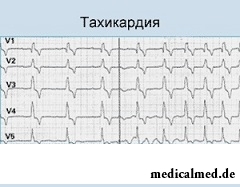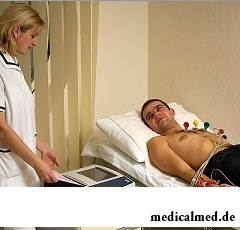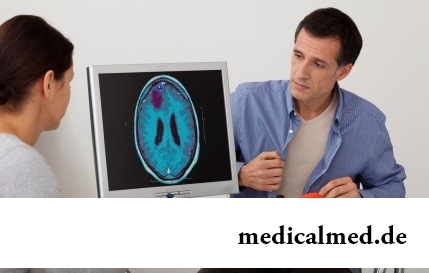





Tachycardia
Tachycardia – a state at which heart rate exceeds 90 beats per minute. Tachycardia can arise as owing to increase in heart rate because of exercise stresses, stressful situations or disorders, well an effect of increase in heart rate at rest.
In certain cases tachycardia can proceed without complications, nevertheless, it can seriously break normal cardiac performance, increases risk of developing of a stroke or can lead to a sudden cardiac standstill and death. Risk factors of development of tachycardia is obesity and diabetes 2 types. Allocate tachycardia sinus, paroxysmal and fibrillation of ventricles.
Sinus tachycardia
Sinus tachycardia call a state when from a sinus node to ventricles carrying out impulses is broken or generation sinus nodes of the impulses controlling cordial a rhythm is broken. It is revealed by means of the electrocardiogram, and external factors, and the wrong functioning of a sinus node can be its reasons both.
Bouveret's disease
Bouveret's disease call a state at which the tachycardia attack, with a frequency of 150-300 beats per minute suddenly arises and stops. Allocate three forms of a Bouveret's disease:
- Ventricular;
- Atrial;
- Uzlovaya.
Increase in activity of a nervous system and dystrophic changes of a myocardium are proximate causes of tachycardia of this type.
Fibrillation of ventricles
Fibrillation of ventricles call a state at which to frequency of 250-480 beats per minute there is a chaotic reduction of fibers of a myocardium which results in lack of reductions of ventricles and a cardiac standstill. Often fibrillation of ventricles is a consequence of the complications caused by an extensive myocardial infarction.
Tachycardia reasons
Disturbances of the autonomic nervous system and hemodynamics, various forms of arrhythmia and disturbance of endocrine system are the most common causes of tachycardia.
Often tachycardia is a consequence of a hypertension, coronary heart disease, myocardial infarction and heart diseases. Also one of origins of tachycardia is the excessive use of caffeine, alcoholic beverages and tobacco smoking. Development of tachycardia is promoted by diseases of a thyroid gland and various infectious diseases.
Tachycardia symptoms
Symptoms of tachycardia are:
- Stethalgia;
- Confusion of consciousness;
- Dizziness;
- Hypotonia;
- Cardiopalmus (pulse);
- Asthma;
- Weakness;
- Syncope.
In certain cases tachycardia can proceed without manifestation of above-mentioned symptoms. In such cases, as a rule, the state is found at medical examination or monitoring of heart.
Diagnosis of tachycardia
Diagnosing of tachycardia happens by medical examination, carrying out a number of inspections, analyses and tests. The general tests for diagnosis are:
- Electrophysiologic research by means of which becomes possible to define a source of problems of cordial system;
- Electrocardiography by means of which define type of tachycardia and its influence on a cordial rhythm;
- Holterovsky monitoring on the basis of which data there is possible a receiving a full symptomatic picture of a disease.
Treatment of tachycardia
The main directions of treatment of tachycardia is prevention of its attacks in the future, minimization of the caused complications and reduction of frequency of a cordial rhythm to a normality. Treatment of tachycardia can be medicamentous, with purpose of special medicines, or can consist in change of a way of life of the diseased, avoidance of stressful situations and good rest.
Caries is the most widespread infectious disease in the world to which even flu cannot compete.

The healthy nutrition is the invariable principle of health and good health for long years of the woman. Nevertheless, in рацио...
Section: Articles about health
The cosmetics intended for improvement of a condition of skin, nails and hair are used by each woman. Expenses on regular acquisition of the fashionable widely advertized products of well-known companies for many become very notable and significantly to an obrema...
Section: Articles about health
"Epilepsy" doctors made the diagnosis in antique times. Displays of an illness and pattern of its development are very well studied. However for nonspecialists this disease remains to not less mysterious, than in the ancient time. Many delusions are connected with epilepsy, and it sometimes very unpleasantly affects quality of life of patients and their relatives. In this article we will try to dispel the most known of similar myths....
Section: Articles about health
About influence of fasting days on an organism it is told much – both about advantages, and about shortcomings. It is considered that fasting day...
Section: Articles about health
Cellulitis - very widespread cosmetic shortcoming which arises approximately at 80% of women sooner or later. Emergence it is connected with change of structure of a hypodermic fatty layer. At the same time on the surface of skin at first there are roughnesses (cambers...
Section: Articles about health
Traveling all over the world, many try to try the most exotic dishes of national cuisines. There is even a so-called gastronomic tourism which, according to gourmets, not only allows to receive new feelings, but also is capable to show life of other people from absolutely unexpected side....
Section: Articles about health
In consciousness of our many compatriots idea that folk remedies if no more эфф strongly took roots...
Section: Articles about health
Separate food - the system of meal based on digestion physiology which is carried to improvement methods. According to nutritionists, the separate use of the carbohydrate and proteinaceous products demanding different conditions of assimilation helps to get rid from Bol...
Section: Articles about health
We present to yours the TOP of the medicamentous means exerting the stimulating impact on a potentiality, i.e. on ability of the man to commission of sexual intercourse. At once it is necessary to tell that not always disturbances of erectile function can be eliminated with reception of this or that drug. The reasons of decrease in a potentiality there can be a set, from banal overfatigue before tumoral process in a small basin therefore if the man faces similar problems too often, it should turn...
Section: Articles about health
All are familiar with cold, and practically everyone believes that he has sufficient knowledge and experience that correctly to treat it. N...
Section: Articles about health
Cystitis, or inflammation of a mucous membrane of a bladder, this very widespread disease which, owing to some features of a structure of bodies of urinogenital system, women have approximately four times more often than men. In the main risk group...
Section: Articles about health
The varicosity has familiarly many, statistically, this disease more than a half of all adult population. As a rule, the varicosis affects preferential superficial vessels, and is shown by characteristic cosmetic defects. The deep vein thrombosis as this illness at the initial stages can imperceptibly proceed is represented much more dangerous, and in the started cases threatens with serious danger – thrombosis. This state, when the blood clot formed...
Section: Articles about health
Practice of use of table salt in the therapeutic purposes contains not one century. Appl are considered especially effective...
Section: Articles about health
Practically each person is familiar with the annoying, pulling, unscrewing pains caused by overcooling of muscles of a back. In certain cases inflammatory process is not limited to discomfort, being followed by emergence of hypostasis, consolidations, increase температ...
Section: Articles about health
The popular expression "run from a heart attack" became the motto of the people supporting active lifestyle. Moreover, run became a peculiar fashionable tendency: sales of racetracks and the accompanying goods for run are at permanently high level. Whether really it is possible for one and all people and it is necessary to run to receive the portion of health, a charge of cheerfulness and good mood?...
Section: Articles about health
The state of health of the person depends on many factors. One of the most important is the constant but which is not exhausting, motive...
Section: Articles about health
Extracorporal fertilization – one of the most modern methods of controlling with infertility. So far he already helped a significant amount of married couples to become happy parents. Usually to the EKO procedure difficult and very expensive, resort in those...
Section: Articles about health
Diseases of joints often begin imperceptibly for the person. The first stages of destruction of the cartilaginous tissue providing soft and free sliding of heads of bones in joint bags proceed slowly and absolutely without serious consequences. Especially unpleasantly for the fact that this process is not connected with advanced age: degradation of joint surfaces is, as a rule, noticeable after 30 years. It means that practically each able-bodied person at any time can face sad results...
Section: Articles about health
All like to sing. Small children with pleasure are engaged in a vocal, not especially thinking of hit in a melody. Adults most often...
Section: Articles about health
Smack in a mouth can arise in the natural way – as a result of lack of morning hygiene or reception of the corresponding food. However in certain cases its existence is a sign of certain pathologies, and allows to reveal an illness at an early stage. In we depend...
Section: Articles about health
Within several decades of our compatriots convinced that the use of butter nasty affects a condition of coronary vessels. As a result the reputation of a product was impaired thoroughly a little, and many almost ceased to include it in the diet, having given preference "to safer" to vegetable fats. Meanwhile, the last researches showed that harm of butter for health is strongly exaggerated. But the product has a number of unique properties, to...
Section: Articles about health
According to World Health Organization, every third inhabitant of Earth has excess weight, and every tenth suffers ожирен...
Section: Articles about health
Life of the modern woman is very difficult. Opportunities to realize itself are wide: it not only education and career, but also the most various hobbies from sport before needlework. It is not less important to build private life, paying an attention maximum to children, the husband, parents, e...
Section: Articles about health
Turnip, radish, horse-radish – once these and other products enjoyed wide popularity at our ancestors, being not only the food sating an organism but also the medicines curing of many diseases. Unfortunately, the use of some of them got out of fashion long ago, and once favourite plants and vegetables almost ceased to make a contribution to human health. Inclusion of such products in a modern diet − an effective measure of prevention and treatment of diseases which seldom suffered...
Section: Articles about health
Dietary supplements (dietary supplements) for the last decades were so thoroughly included into our life that, apparently, it is already impossible on...
Section: Articles about health
Coffee – favourite drink of many. For the last decades it more than once already declared very harmful, extremely useful and even necessary for normal life activity. In spite of the fact that this product became for us usual for a long time, exists much...
Section: Articles about health
Proofs of efficiency of Mildronate at treatment of coronary heart disease with stenocardia can be found in many publications of the end of the twentieth century. Researches were conducted since 1984, including placebo - controlled effects. In total clinical tests of Mildronate were carried out for more than thirty years....
Section: Articles about health
